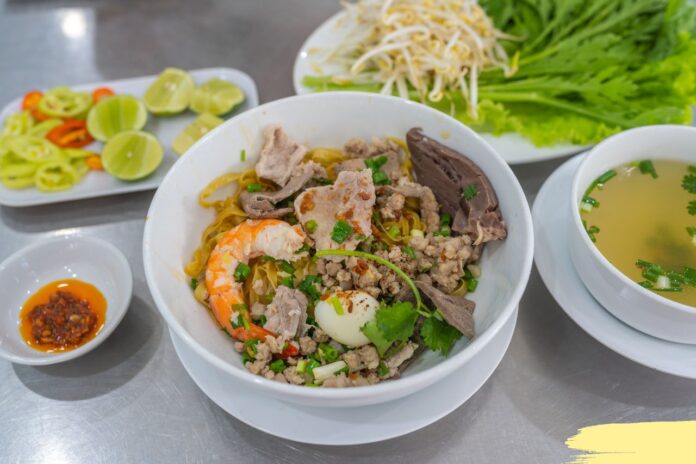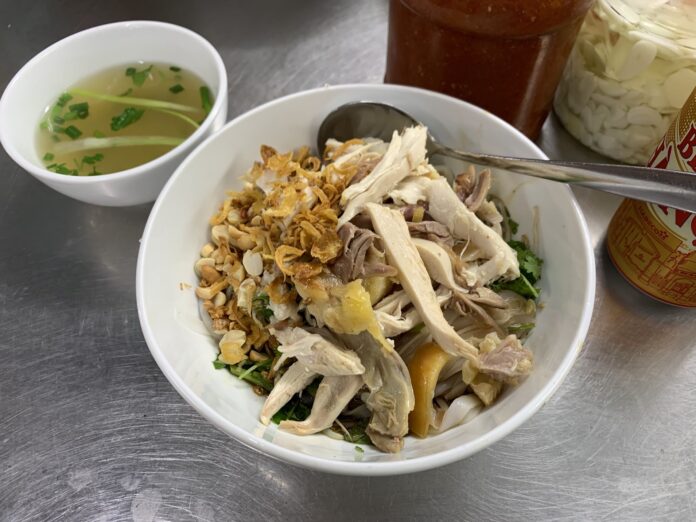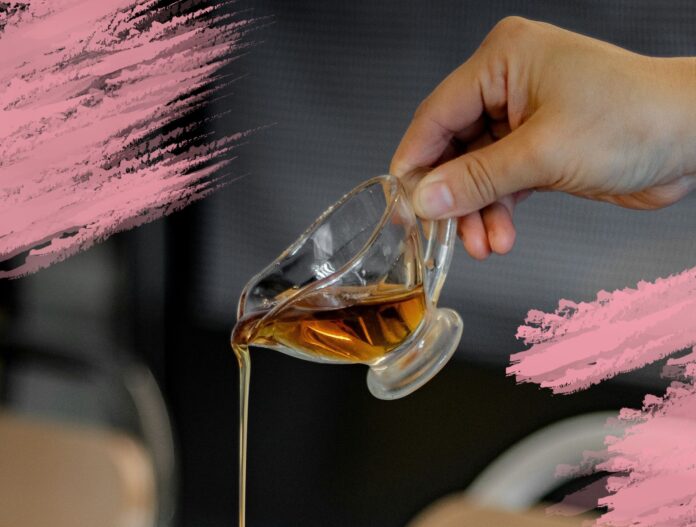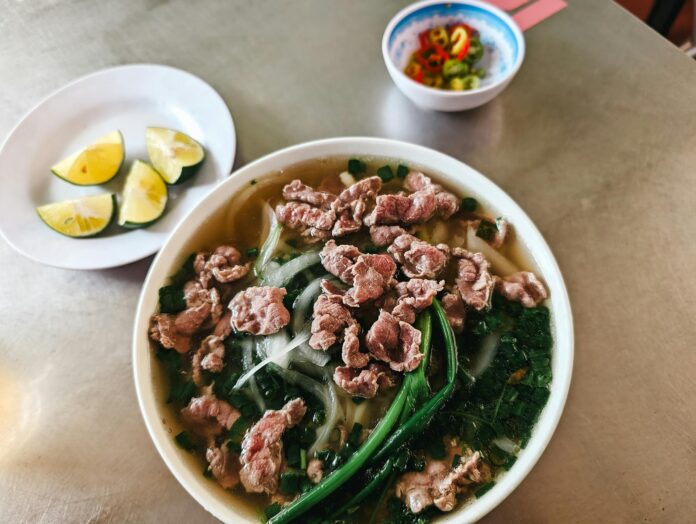Weddings seem to exist in a parallel economy where normal rules don’t apply. A cake that would cost £30 in a bakery suddenly costs £600 because you’ve added the word “wedding” to it.
Wedding catering can devour nearly half your entire budget if you’re not careful. But feeding your guests matters. Nobody wants their wedding to be remembered as “that one where we left to get chips on the way home.” The trick is serving something memorable without remortgaging your future.
The wedding industry knows ceremonies command premium pricing. However, you’ve got more negotiating power than you realise. So here, with the weary authority of an editorial team who’s attended seventeen weddings in the last two years between us, and who have strong opinions about vol-au-vents, are ten ways to keep your catering costs sane.
Limit Your Menu Choices
The more options you offer, the more it costs. Not just in ingredients, but in preparation time, staff coordination, and logistical complexity for the caterer. When you request three starter options, three main courses, and four desserts, you’re asking them to run multiple kitchens simultaneously. That complexity gets passed straight to your invoice.
The sweet spot is one starter (two at most), one main with a vegetarian alternative, and one dessert. Your guests won’t feel shortchanged. Nobody has ever left a wedding thinking ‘if only there’d been another starter option’. They’re there for the celebration, the atmosphere, and the company.
Limiting choices also means less food waste. When guests pick from five mains, the caterer must prepare a bit of everything. Half often ends up binned. A streamlined menu lets your caterer focus on quality over quantity. One brilliant dish beats five mediocre ones every time.

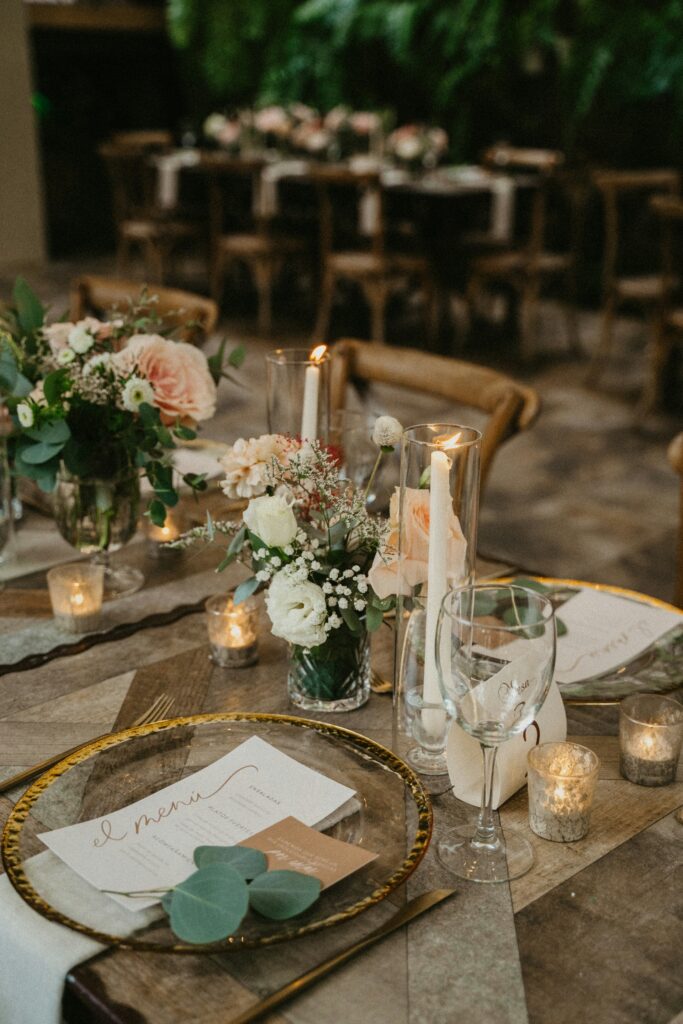
Go Seasonal With Your Ingredients
Asparagus in December costs triple the price. Strawberries in February require both deep pockets and a willingness to overlook their disappointing flavour. Seasonal ingredients aren’t just cheaper – they actually taste like themselves as they haven’t been flown halfway round the world or stored in warehouses for months to ripen.
Spring weddings should feature lamb, new potatoes, and fresh greens. Summer means berries, salads, and lighter fare. Autumn brings game, root vegetables, and rich flavours. Winter calls for roasted meats and comfort food.
Most caterers will light up if you ask what’s in season. It simplifies their job and the food genuinely shines. You’re working with nature rather than fighting it. There’s something quietly satisfying about a menu that reflects its moment – a winter wedding serving an eton mess feels like someone didn’t think things through.
Consider Buffet-Style Service
Plated service looks elegant, certainly. But it requires more waitstaff, more precise timing, and more complexity. Buffets slash labour costs dramatically. You might need three servers instead of eight. That’s five people’s wages saved, which – let’s be honest – is quite a lot of prosecco.
The concern is understandable – buffets can feel a bit kids’ birthday party. However, done properly with beautiful warming stations, clear signage and proper presentation, they can look spectacular. According to the Bridebook.com the average cost of a buffet is usually around £20-30 per head, which is considerably less than the price for a three course meal.
For the best of both worlds, you can incorporate buffet elements into formal meals too. Instead of individually passed canapés during the reception (at £3 to £5 each, which somehow seems reasonable until you multiply it by 100 guests), create a canapé station where guests serve themselves. Think a whole serrano ham with good bread and lots of cheeses. It feels abundant and generous whilst costing significantly less.
At the meal’s end, consider a dessert bar instead of plated individual desserts. Display various cakes, doughnuts, tarts, and treats on an attractive table where guests can serve themselves. This approach costs substantially less than individual plating. Also, guests enjoy choosing their own portions and trying multiple options. Moreover, guests can control their own portion sizes – your uncle who eats like a sparrow and your mate who’s perpetually ravenous both leave satisfied.
Read: 15 Ideal food station ideas for your wedding
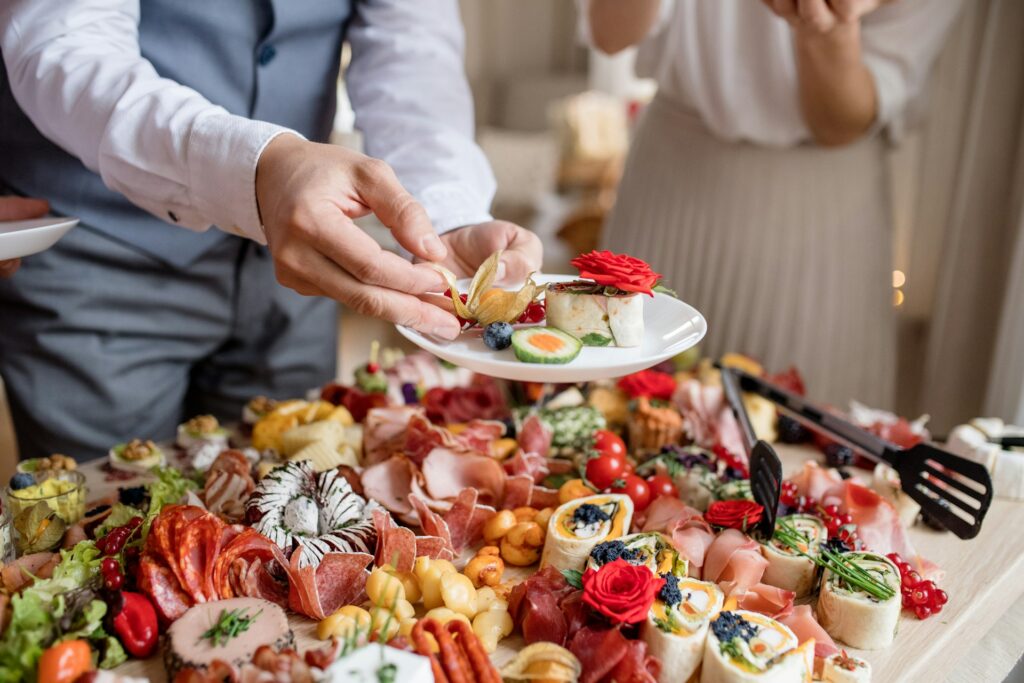
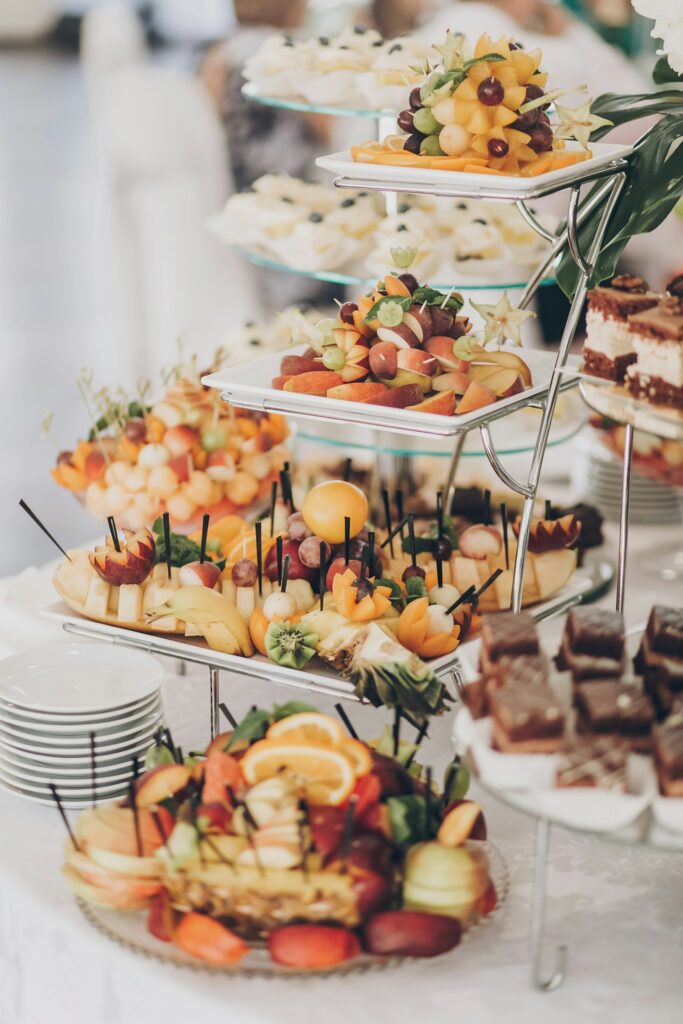

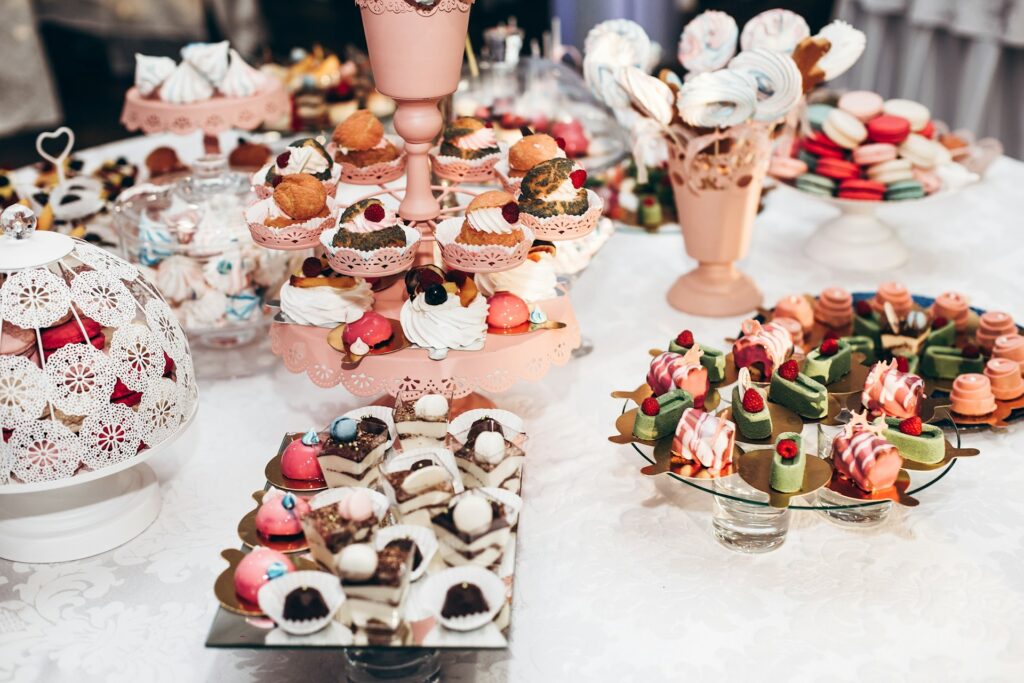
Embrace Sharing Feasts
Sharing feasts have become fashionable, which is convenient because they also make financial sense. Large platters placed centrally on each table – whole roasted chickens, generous bowls of sides, bread baskets, seasonal salads. It looks lavish and feels celebratory whilst requiring fewer servers than individual plating.
There’s something lovely about the communal aspect too. People pass dishes, make recommendations, bond over food in a way that doesn’t happen when you’re staring at your own individual plate wondering if you should’ve ordered the fish. It feels less like a formal dinner and more like a very good dinner party where someone else did the washing up.
It also reduces waste. Guests take only what they’ll eat, and leftovers stay on the table for second helpings rather than being scraped into bins. From a catering perspective, preparing 15 large platters is simpler than plating 150 individual portions. Those savings get passed to you, which you can spend on better wine or therapy after dealing with your future mother-in-law’s opinions about table runners.
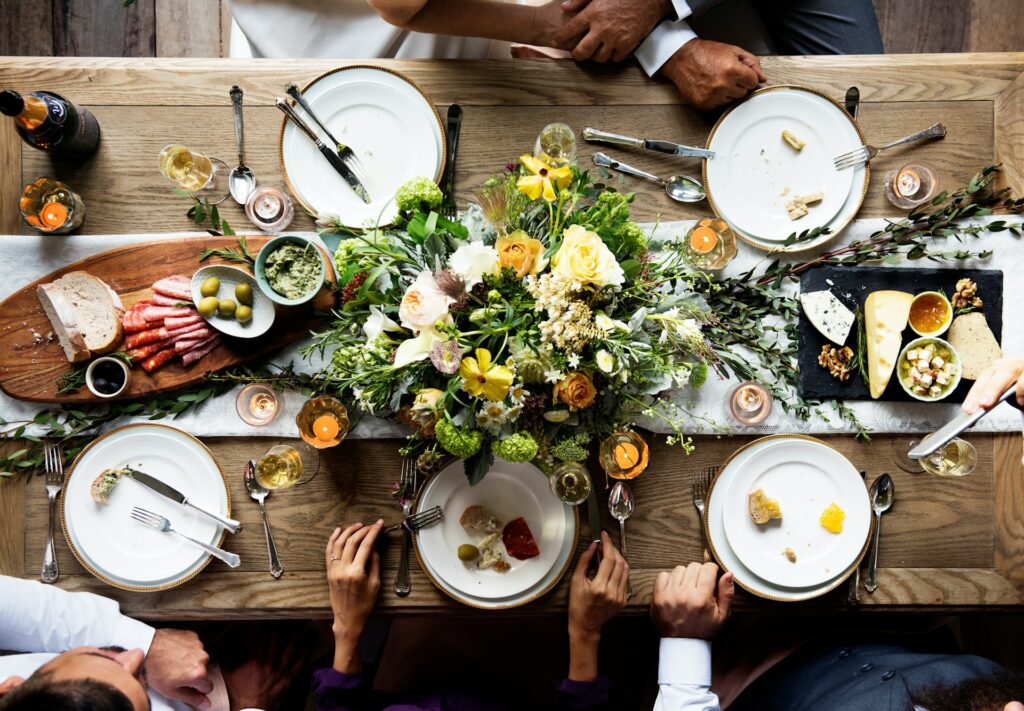
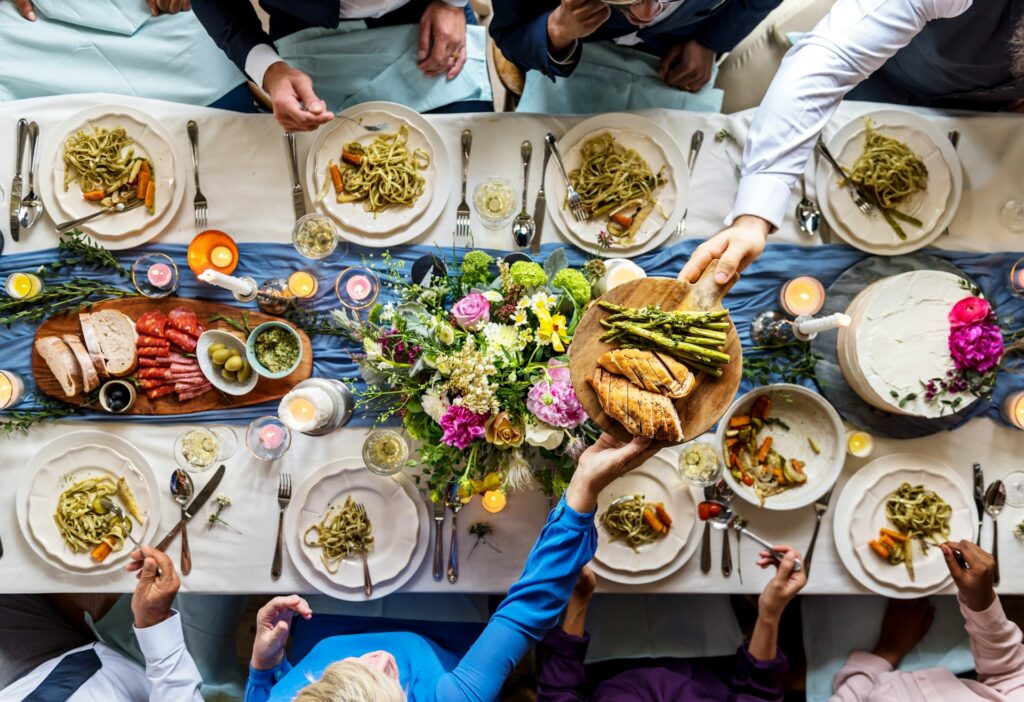
Choose a Flexible Caterer
Some caterers offer rigid packages: Bronze, Silver, Gold. Take it or leave it – a bit like choosing a mortgage product. Others actually collaborate with you to create something bespoke that fits your budget and preferences. These are the good ones.
The best wedding caterers ask questions. What matters most to you? Where can you compromise? Would you rather have spectacular mains and simple starters, or vice versa? Do you care more about the wedding breakfast or the evening food? These aren’t trick questions – they’re genuinely trying to help you spend money wisely.
A flexible caterer scales service to your exact guest count. If you’ve got 73 guests, you pay for 73 guests. Not 75, not 80, not “packages of 50 with a supplement for extras.” They’ll suggest alternatives when you mention something expensive. “Lobster? What about crab – it’s £20 per head cheaper and equally special.” That collaborative spirit saves serious money.
Don’t book the first caterer you meet. Interview at least three. Ask about flexibility, dietary requirements, customisation. Their answers reveal everything about whether they see you as a person or a profit margin.
Rethink Your Drinks Strategy
Alcohol is where costs spiral out of control faster than your ability to track them. An open bar all night with premium spirits can cost £3,000+ for 100 guests. That’s more than most people’s monthly salary, spent on getting your cousin drunk enough to request “Mr Brightside” for the fourth time.
Try a limited bar instead. Beer, wine, perhaps one signature cocktail. No spirits, or spirits for the first hour only then beer and wine. Your guests will survive. Nobody has ever left a wedding thinking “it was lovely but the lack of vodka variety really diminished the experience.”
House wine instead of premium labels saves £5 to £8 per bottle. Over 50 bottles, that’s £250 to £400. Nobody can tell the difference after the second glass anyway, and anyone claiming they can is lying. Some venues let you supply your own alcohol. If yours does, buy from a supermarket and return unopened bottles. The savings are enormous.
You can also offer miniature bottles of spirits as wedding favours – small “drink me” style bottles of limoncello, damson vodka, or vermouth. Make them yourself or buy in bulk, add personalised tags, and suddenly you’ve created a sense of abundance without maintaining a fully stocked bar all evening. Guests can drink them at the reception or take them home, and you’ve essentially given them another free drink whilst controlling costs.

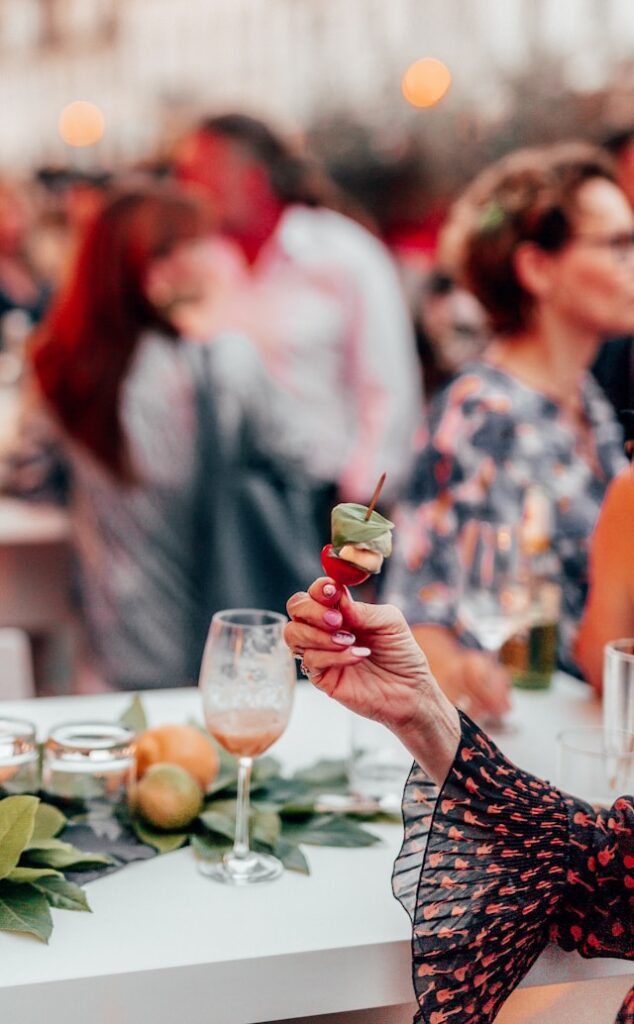
Think Outside Traditional Meal Times
A full three-course wedding breakfast is expensive. Afternoon tea is cheaper. So is brunch.
An 11am ceremony followed by champagne brunch reception can cost half what an evening dinner costs. You’re serving breakfast foods – which are inherently cheaper – and people don’t expect as much. Pastries, smoked salmon, fruit, perhaps some hot options. Nobody feels shortchanged. They feel virtuous for having accomplished something before noon.
Afternoon tea is another brilliant option. Sandwiches, scones, cakes, tea and coffee. It looks gorgeous on tiered stands, photographs beautifully, and costs perhaps £15 to £25 per person instead of £50 to £70. Plus it suits the kind of wedding where your grandmother wears a hat and everyone remains reasonably sober.
Evening receptions with just canapés or street food eliminate the sit-down meal entirely. Guests graze, mingle, dance. The atmosphere becomes more party than formal dinner, which some people prefer and others find horrifying. Know your audience.
These options don’t suit everyone. Some couples want the traditional wedding breakfast, and that’s completely valid. But if you’re flexible about structure, the financial benefits are substantial.
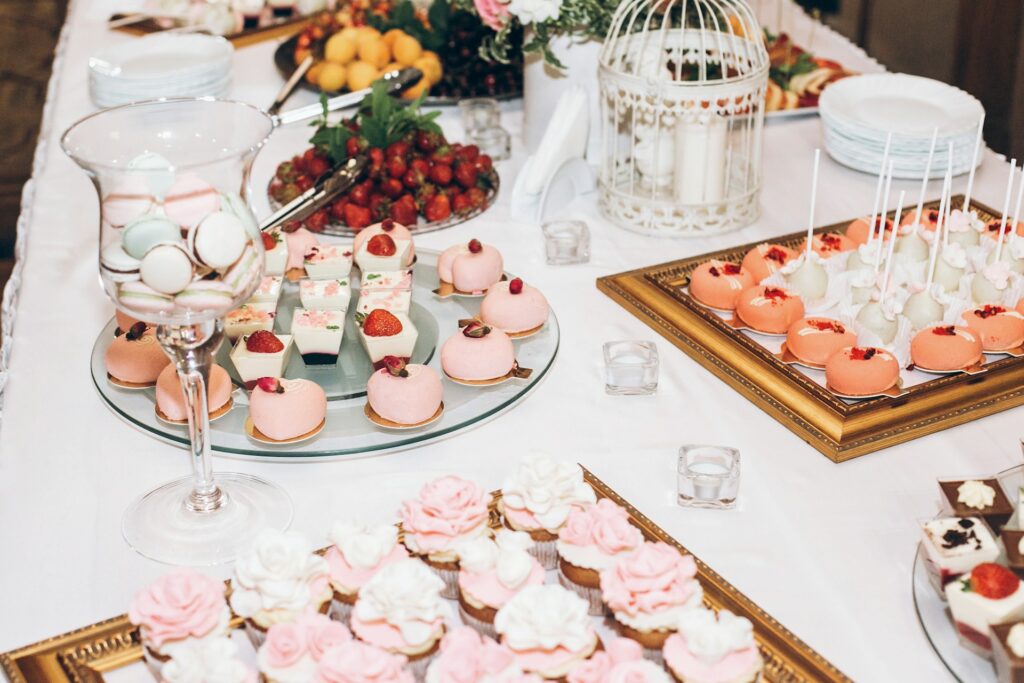
Negotiate on Service Staff
Caterers bundle food costs with service staff costs, but these are negotiable separately. How many staff are they providing? What’s each person’s role? Sometimes you’ll discover you’re paying for six servers when four would suffice. That’s potentially £400 to £600 saved, which is a week’s groceries or several months of therapy to process the wedding planning experience.
Service length matters too. Do staff need to stay until midnight or can they finish at 10pm once meal service concludes? Every hour costs money. Some couples recruit family members to help with simple tasks like cutting and serving cake. If you’ve got willing volunteers, it’s an option—though you want your family enjoying themselves rather than working.
Rethink Your Wedding Cake
Traditional tiered wedding cakes look spectacular and cost more that £400, which seems excessive for something that gets eaten in approximately four minutes. Consider an alternative: a tiered “cake” made from wheels of cheese.
Stacked cheese wheels create a stunning centrepiece for photos and cutting ceremonies. Later in the evening, they become a proper cheeseboard served with crackers, chutneys, and grapes. This transforms into substantial late-night food when guests get peckish after dancing, which they absolutely will.
Cheese and crackers go much further than cake slices. They’re more filling, and guests can return for seconds throughout the evening. A good selection of cheddar, brie, and stilton costs significantly less than an elaborate cake, particularly if you buy from wholesalers or supermarkets rather than specialist wedding cake makers who’ve correctly identified that people getting married have temporarily lost their sense of financial reality.
You can still have a small traditional cake for those who prefer something sweet – perhaps a single-tier cutting cake displayed alongside the cheese. But the cheese wheels provide far better value and practical sustenance – that is unless you make the cake yourself of course.

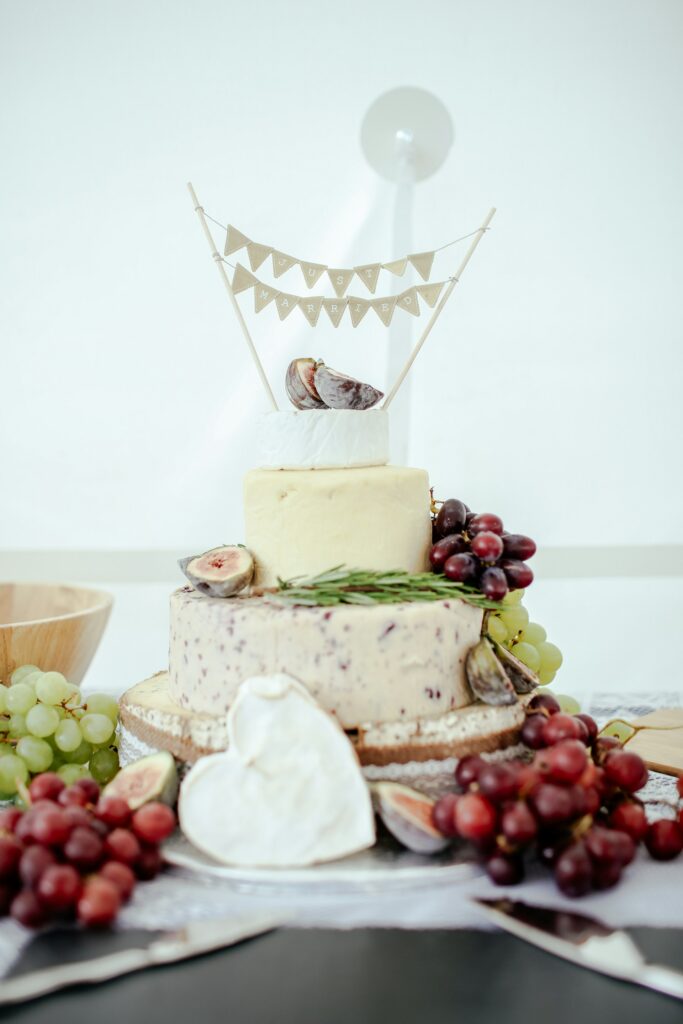
Consider a Food Truck
Food trucks have become increasingly popular at weddings, which is fortunate because they’re also significantly cheaper. Pizza trucks, taco trucks, fish and chip vans – these offer substantial, crowd-pleasing food at a fraction of traditional catering prices.
A food truck typically charges £8 to £15 per person compared to £40 to £70 for traditional sit-down catering. The informal atmosphere suits relaxed, outdoor, or evening weddings particularly well. Guests enjoy the novelty and the food arrives hot and fresh throughout service.
Pizza trucks work brilliantly. Everyone loves pizza, dietary requirements are easily accommodated, and the visual spectacle of a wood-fired oven adds entertainment value. Taco trucks offer similar benefits with endless customisation options.
Fish and chip vans bring a quintessentially British touch, especially for seaside or summer weddings. Served in proper paper with wooden forks, it’s comforting, filling, and nostalgic. Setup and cleanup are entirely handled by the truck operator, saving you hassle and the existential dread of coordinating logistics.
The main consideration is venue access and space. You’ll need adequate room for the truck to park and serve, plus electrical hookups if required. Some venues restrict external caterers because they have exclusive arrangements or simply enjoy making things difficult. But if your venue allows it, a food truck delivers fantastic value without compromising guest satisfaction.
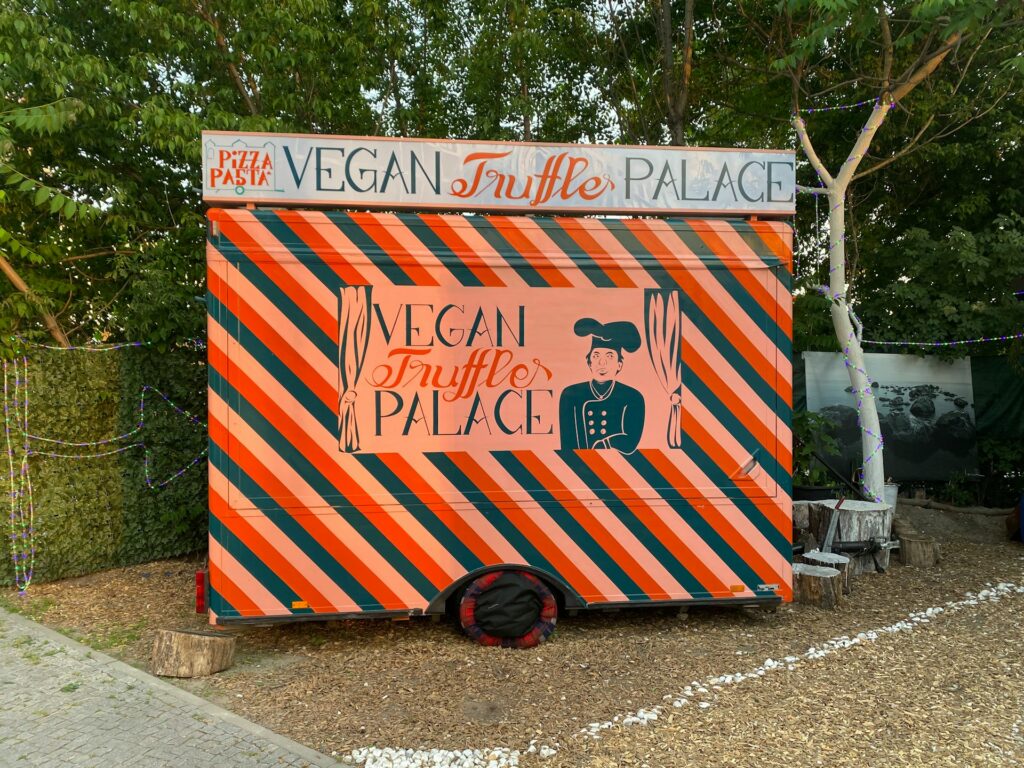
Scale Back The Extras
Wedding catering often includes extras that sound lovely but aren’t essential. That late-night burrito? Lovely, but £500 you might not need to spend. The artisan bread selection? Standard bread works fine. The elaborate garnishes nobody eats? Save your money.
Canapés during drinks reception can be scaled back. Six varieties aren’t necessary when three well-chosen options will do. Each additional canapé type adds labour and ingredient costs that accumulate faster than you’d expect. Dessert is another area where couples overspend. If you’re having a wedding cake, do you really need individual plated desserts too? The cake can be your dessert. Or offer a simple option like ice cream or sorbet alongside the cake.
Coffee service doesn’t need to be elaborate. Standard filter coffee with milk and sugar is perfectly acceptable. You don’t need a barista station with six types of milk and flavoured syrups.
Be creative with optional extras too. One wedding trend that took TikTok by storm involved offering £1 Pot Noodles as late-night snacks for guests. Simply set up a station with instant noodles, a hot water dispenser, and chopsticks – guests can prepare their own midnight snack after dancing. It’s quirky, nostalgic, and costs a fraction of traditional late-night catering. Plus, it actually serves a practical purpose: soaking up alcohol and giving hungry dancers a warm, filling snack. You could even customise the pots with your wedding details for a personal touch.
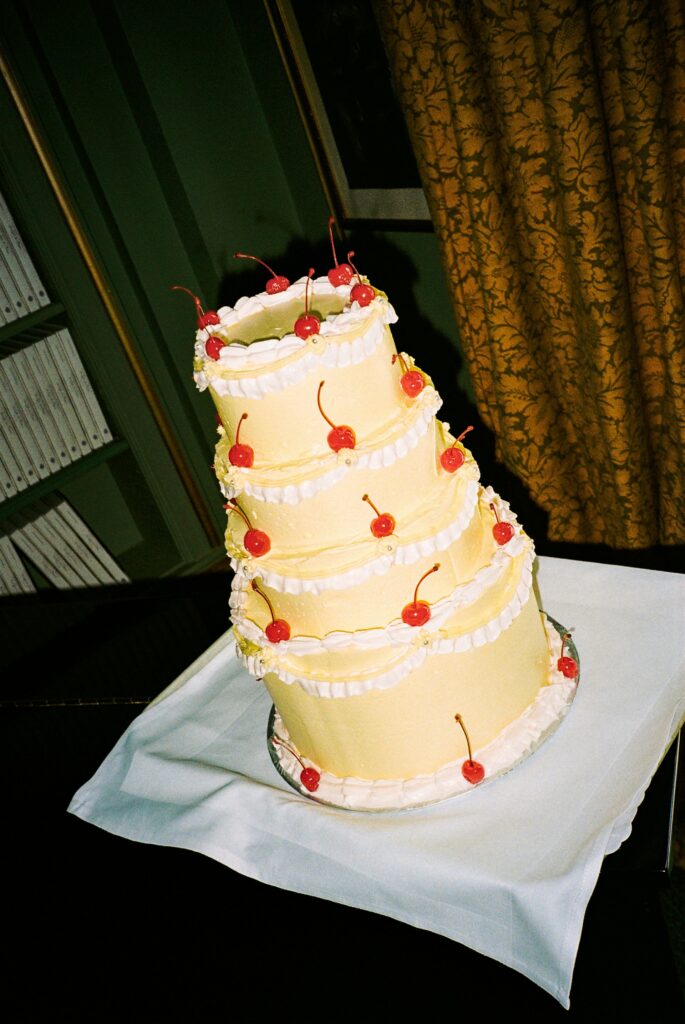

The Bottom Line
Saving money on wedding catering doesn’t mean serving inferior food or leaving guests hungry. It means being smart, strategic, and willing to question the “standard” way of doing things that the wedding industry insists is mandatory.
The wedding industry loves to tell you that everything must be premium, elaborate, and expensive. But some of the best weddings feature simple, well-executed food that doesn’t try too hard. Great ingredients, seasonal flavours, generous portions. That’s what people remember, along with whether the speeches were too long and if anyone embarrassing got drunk.
Your wedding should feel like you, not like every other wedding. If that means afternoon tea instead of a five-course dinner, or a gorgeous autumn menu instead of imported delicacies, then embrace it. Your bank account will thank you and your guests will have a brilliant time regardless.

